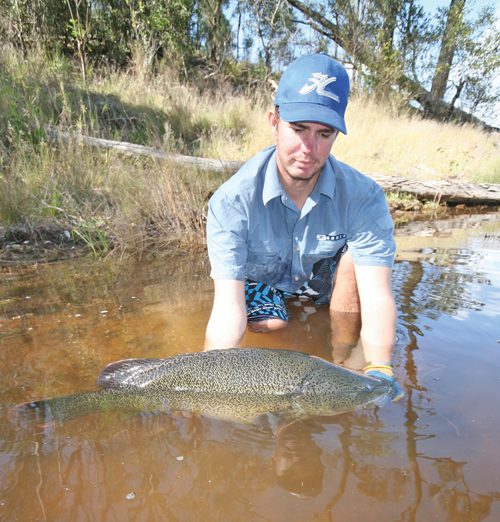One cloudy Sunday morning during late November saw a small gathering of volunteers huddled around the fish transportation vehicle from Hanwood Fish Hatchery, unloading a very precious cargo. Cod recovery Brisbane
That shipment consisted of 5200 tiny Mary River cod fingerlings, destined for release into the upper Brisbane River and its tributaries. Cod recovery Brisbane
It is important that we should condition ourselves to call these fish by their correct name Mary River cod (maccullochella peelii mariensis), and not Murray cod nor east coast cod, which are both distinctly different species. Cod recovery Brisbane
The Brisbane River was once home to a species of cod almost identical to the Mary River cod.
Unfortunately, following exhaustive investigation 30 years ago, the Brisbane River strain was presumed extinct.
The last substantiated capture was in fact recorded back in the early 1950s.
During 15 years in the 1980s and early 1990s, extensive searches with all available capture methods failed to produce a single specimen of the Brisbane River strain of cod.

The Mary River cod was facing a similar fate until captive breeding techniques were perfected by Gerry Cook at Lake MacDonald.
The first release of Mary River cod into the middle reaches of the Brisbane River was made on February 15, 1997.
Those initial 350 cod fingerlings, supplied by Manning’s Freshwater Fish Hatchery at Cooroy, were released by the Brisbane Valley Anglers.
Subsequent releases have been undertaken periodically in the Brisbane system, but efforts have been hamstrung by the unreliable availability of fingerlings.
Fish farming is the same as terrestrial farming – subject to the whims of Mother Nature, with drought, heat waves, disease and such reducing production.
Current releases are being conducted as part of the Brisbane River Cod Recovery Project, a commendable scheme driven by the volunteer members of the Somerset and Wivenhoe Fish Stocking Association.
Securing the future of cod in the Brisbane River system is the primary objective of this exceedingly worthwhile project.

The environmental and social value of the recovery project has seen contributions of funding, manpower and expertise from other stakeholders, including Somerset Regional Council, Ipswich City Council, Department of Agriculture and Fisheries Queensland, Transport and Main Roads, Healthy Land and Water and the Grand Wivenhoe Fishing Club.
Those of you who frequent the freshwater reaches of the river will be painfully aware of the high percentage of introduced pest species of fish in the biomass.
Reintroducing the top aquatic predator to the system may see the balance return to a closer approximation of the natural order.
Socially, the benefits go beyond the satisfaction of seeing the ecology of the river improved – there is of course the angling potential that this strikingly handsome fish will offer.
Given their relative scarcity, slow reproduction and growth potential, all anglers should treat them as the living treasures they are and release them without lifting them from the water.
Totally abstaining from fishing for any species in riverine waters containing cod during the spawning season will give them the best chance of reproducing successfully.
For more stories from our January 2022 issue, click HERE









